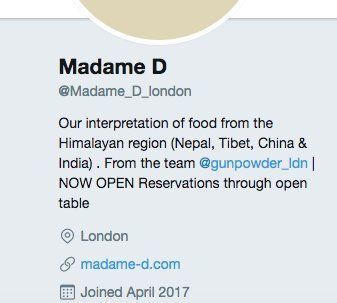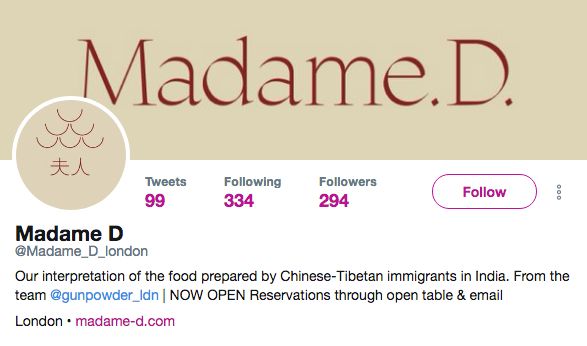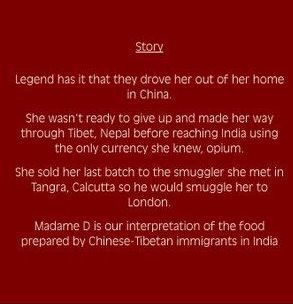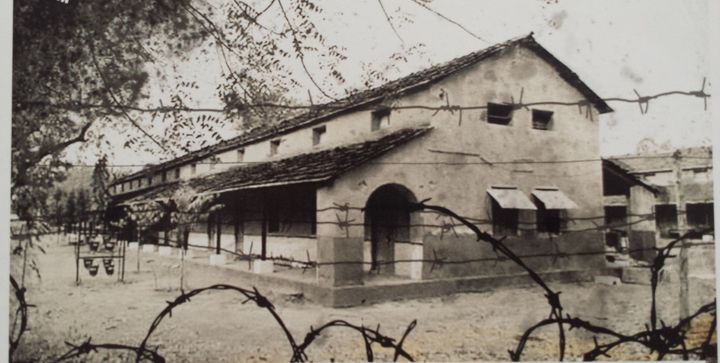
***UPDATE 4 July, 2017***
Madame D changed their restaurant description on their Twitter and Facebook on the morning of 3 July! They also unblocked me on Twitter.

Screenshot of Madame D’s Twitter bio which was corrected following the publishing of this article
***
New restaurants open all the time in London and I enjoy eating out as much as the next person - maybe even more! Last year I had a spectacular meal at Gunpowder in Spitalfields on the recommendation of a friend who was aware of my obsession with Dishoom.
So earlier this year I was intrigued to learn that the team behind Gunpowder were opening a new restaurant called Madame D, also in Spitalfields. In April, an article in the Evening Standard signalled the imminent arrival of Madame D promising “dishes that draw on Indian, Nepalese, Tibetan and Chinese cooking — the bedrocks of Himalayan cuisine”. Himalayan cuisine? I was excited! And then I read this:
Dishes [...] will include garlic coriander steamed chicken, prawn toast and a selection of dumplings including pan-fried Tibetan duck momo and so-called gold coin dumplings, named for their shape.
Pan-fried duck momos? What?! When have we ever filled momos with duck? I was sceptical and we Tibetans can get extremely hot under the collar if momos are messed with. Having said that, these days you can get all kinds of non-traditional momo fillings and they can be yummy. I’ve had chocolate momos in Ladakh, apple momos in Labrang in Tibet and I’m very much enjoying how momos are becoming increasingly available in London. A Tibetan family have been running a momo stall every weekend over on Brick Lane for years and offer beef, lamb, chicken and vegetarian fillings. The pop-up Momo Shack has been gaining popularity, and there’s always Kailash Momo Restaurant down in Woolwich.
Aside from the duck momos, what next caught my attention was much more serious. Madame D’s Twitter bio was (and still is) as follows:

Chinese-Tibetan immigrants in India. It took me a while to take in that confusing term. Who are these immigrants? Did they mean Tibetan refugees who had fled to safety in India after 1959, including the Dalai Lama? Is he an immigrant now? I’ve never heard him described as one! Of course there were some Tibetans living in India before 1959 but then wouldn’t they just be Tibetans and not Chinese-Tibetan? Not even in China today does the term Chinese-Tibetan exist, Tibetans are Tibetan (藏族, ethnic group) on their ID cards.
The back story offered on Madame D’s website goes like this:

Whoever dreamt up this legend had quite the imagination. Let’s leave aside the story of opium that comes straight out of an exotic Hollywood stereotype of Asia, reminiscent of “The World of Suzie Wong”. As a business, I guess a bit of nonsense is permissible. However, using the term Chinese-Tibetan immigrants reveals the owners are insensitive to the politics of naming and ill-informed about history.
First of all, Tibetans in India dislike being described as Chinese, they also do not see themselves as immigrants. The vast majority of Tibetans in India are not exactly there by choice. Furthermore, getting the term right is not just for the sake of political correctness in the West, in India the pejorative term “Chinky” is used to describe people who are from northeastern states as well as Tibetans, Nepalis, Bhutanese or Burmese. This racism and discrimination sparks riots and has become a hot political debate within India.
What is true is that India did have a large Chinese population at one point, particularly in port cities like Calcutta. However, in 1962, after losing a border war with China, India rounded up around 3000 people of Chinese descent living in India’s northeast (most of them were Indian citizens) and sent them to an internment camp in Rajasthan called Deoli. Among them were over 100 Tibetans and the Indian authorities called them Chinese-Tibetan.

Photo of Deoli Internment Camp, Rajasthan.
Considering this might be the only time in history that this term has been used, it’s highly insensitive, if not downright offensive, for Madame D to be using it in their restaurant description. It would only be accurate if they were re-creating the food from the 100 or so prisoners the Indian government termed Chinese-Tibetan for political reasons. That doesn’t seem to be the case.
It’s 2017. It shouldn’t have to be explained that refugees are not immigrants, refugees are forced out of their home countries whereas immigrants move voluntarily, for economic or family reasons. There are over 100,000 Tibetans currently living in India who are refugees. More accurately, they are stateless, they’ve been there for generations now but are not afforded the same rights as Indians.
Language is important and the fact that both Madame D and Gunpowder blocked me on Twitter for calling them out on using this phrase was unhelpful. If Madame D want to serve momos, even if they have duck filling, I can live with that. But using the term Chinese-Tibetan immigrants is highly ignorant of history, offensive to Tibetans and needs to be corrected.
